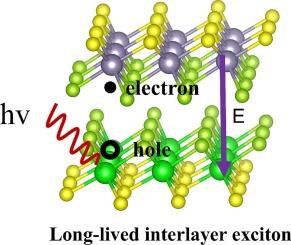ZrSSe/SnSSe异质结构中可调谐激子寿命的第一性原理研究
IF 6.9
2区 材料科学
Q2 CHEMISTRY, PHYSICAL
引用次数: 0
摘要
激子效应对于二维材料在发光器件、激子器件以及其他光物质相互作用相关领域的应用具有重要意义。本文基于第一性原理计算,利用GW近似和求解Bethe-Salpeter方程(BSE),研究了单层ZrSSe和ZrSSe/SnSSe异质结构的准粒子能带结构和激子相关光学性质。结果表明,单层ZrSSe具有较大的激子结合能(0.53 eV)和ps级激子寿命。此外,ZrSSe/SnSSe异质结构的四种稳定堆叠构型均呈现ii型能带结构,有利于层间激子的产生。ZrSSe/SnSSe异质结构中激子波函数的实空间分布表明,能量最低的激子是层间激子,第一个强吸收峰激子是层内激子。更重要的是,所有四种堆叠都具有大的激子结合能(0.314 ~ 0.351 eV)和长激子寿命(0.42 ~ 36.89 ns)。不同堆叠方式产生的本征界面电场可调节带隙和激子寿命。这些发现为单层ZrSSe和ZrSSe/SnSSe异质结构作为光电器件材料的潜在应用提供了新的见解。本文章由计算机程序翻译,如有差异,请以英文原文为准。


First-principles study of tunable exciton lifetime in ZrSSe/SnSSe heterostructures
The excitonic effect is of great significance for the application of 2D materials in light-emitting devices, excitonic devices, and other light-matter interaction-related fields. In this work, based on first-principles calculations using the GW approximation and solving the Bethe-Salpeter equation (BSE), the quasiparticle band structures and exciton-related optical properties of monolayer ZrSSe and ZrSSe/SnSSe heterostructures were investigated. The results show that monolayer ZrSSe has a large exciton binding energy (0.53 eV) and an exciton lifetime at the ps level. Furthermore, the four stable stacking configurations of the ZrSSe/SnSSe heterostructures, exhibit type-II band structures, which are favorable for the generation of interlayer excitons. The real-space distributions of exciton wave functions in ZrSSe/SnSSe heterostructure indicate that the lowest energy excitons are interlayer excitons, and the first strong absorption peak exciton are intralayer excitons. More importantly, all four stackings have large exciton binding energies (0.314–0.351 eV) as well as long exciton lifetimes (0.42–36.89 ns). The bandgap and exciton lifetime could be regulated by the intrinsic interfacial electric field arising from different stackings. These findings provide new insights into the potential applications of monolayer ZrSSe and ZrSSe/SnSSe heterostructures as optoelectronic devices materials.
求助全文
通过发布文献求助,成功后即可免费获取论文全文。
去求助
来源期刊

Applied Surface Science
工程技术-材料科学:膜
CiteScore
12.50
自引率
7.50%
发文量
3393
审稿时长
67 days
期刊介绍:
Applied Surface Science covers topics contributing to a better understanding of surfaces, interfaces, nanostructures and their applications. The journal is concerned with scientific research on the atomic and molecular level of material properties determined with specific surface analytical techniques and/or computational methods, as well as the processing of such structures.
 求助内容:
求助内容: 应助结果提醒方式:
应助结果提醒方式:


